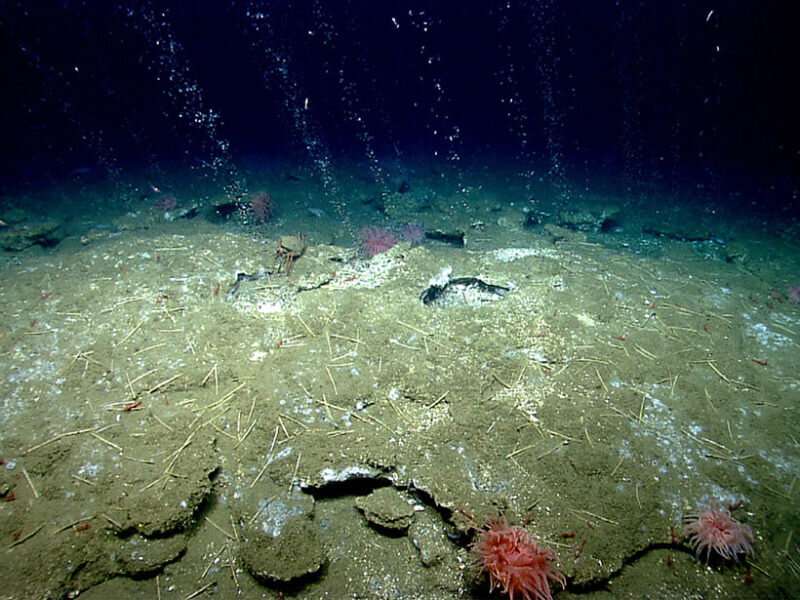Methane streams rise from the seafloor at a cold seep site offshore of Virginia. A new study shows that underwater decomposition is a significant process for disposing of organic matter in both terrestrial and aquatic environments. Credit: NOAA Okeanos Explorer Program, 2013 Northeast U.S. Canyons Expedition
In microbiology, the priming effect is the observation that the decomposition rate of organic material is often altered by the introduction of fresh organic matter. Depending on the context, the effect can be the increase or reduction of microbial consumption and a corresponding change in emitted carbon dioxide.
Although the mechanism isn't fully understood, several contributing processes have been proposed. They include the shift of some specialist microbes to the consumption of only fresh or only older material, as well as increased decomposition of stable (older) matter in search of specific nutrients needed to sustain growth enabled by the addition of fresh material.
The priming effect has been well established in terrestrial soils, but experimental evidence has appeared more mixed in aquatic environments. Both the magnitude and the direction (i.e., increase versus decrease) of the effect have been contradictory in a variety of studies conducted in the laboratory and the field.
Sanches et al. performed a meta-analysis of the literature in an attempt to resolve these difficulties. The authors identified 36 prior studies that published a total of 877 results matching their experimental criteria. Of the subset that directly estimated priming, about two thirds concluded that there was no priming effect, with the majority of the remainder indicating an acceleration in decomposition. However, these past studies used a wide variety of metrics and thresholds to define the priming effect. Many others did not directly calculate the magnitude of the effect.
To overcome the range of methodologies, the researchers defined a consistent priming effect metric that can be calculated from the reported data. With this metric, they found support for the existence of a positive priming effect. Namely, the addition of new organic material increases decomposition on average by 54%, with a 95% confidence interval of 23%–92%. They attribute this divergence from the aggregated conclusions described above to a significantly larger data set (because they could calculate their metric even when the original authors did not), which enabled increased statistical significance.
The meta-analysis also indicated which experimental factors were most correlated with an observed priming effect. One key factor was the proxy chosen for microbial activity, as well as the addition of any other nutrients, such as nitrogen or phosphorus. Finally, the authors noted that other recent meta-analyses using differing methodologies have reported no priming effect; they concluded that the umbrella term "priming effect" may be better split into several terms describing related, but distinct, processes.
More information: Lúcia Fernandes Sanches et al, Exploring the Drivers Controlling the Priming Effect and Its Magnitude in Aquatic Systems, Journal of Geophysical Research: Biogeosciences (2021). DOI: 10.1029/2020JG006201
Provided by American Geophysical Union
This story is republished courtesy of Eos, hosted by the American Geophysical Union. Read the original story here.
























